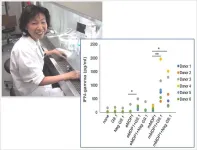Measuring the heart rate of great apes in captivity is essential for both health management and animal studies. However, existing most methods are either invasive or inaccurate. Now, researchers from Japan have investigated the potential of using millimeter-wave radar technology to estimate heart rate from subtle body movements in chimpanzees. Their efforts will hopefully pave the way to better practices and techniques for monitoring heart rates in wild and captive primates.
Just like in humans, heart rate is a critically important and informative vital sign in nonhuman primates. Heart diseases are among the main causes of death of nonhuman primates in captivity, and monitoring their heart rate regularly can help veterinarians catch symptoms early. Beyond the obvious health reasons, monitoring heart rate is also really useful in animal cognitive studies. For example, it has been well documented that a chimpanzee’s heart rate changes under psychological stress, when emotionally aroused by images, or when encountering familiar humans.
Thus, it's no wonder a few techniques have been devised to measure heart rate in great apes. Besides standard contact measurements, the most prevailing one consists of attaching a wireless device to the animal to monitor and transmit its heart rate remotely. However, installing the device often requires anesthesia, which carries risks. Moreover, the device itself might cause stress to the animal or others in its group. A less invasive approach is the estimation of heart rate from video feed, which has been tested in some species of primates. Still, the accuracy of these methods is quite sensitive to lighting conditions and the movement of the animals.
Against all these backdrops, a research team including Asisstant Professor Takuya Matsumoto from Shinshu University, Japan, set out to find a better alternative. In their latest study, which was published in the American Journal of Primatology on May 22, 2024, the researchers investigated whether millimeter-wave radar-based techniques originally developed for humans could be used to measure heart rate in chimpanzees. The co-authors include Dr. Itsuki Iwata, Dr. Takuya Sakamoto, and Dr. Satoshi Hirata, all affiliated with Kyoto University.
In essence, the proposed approach involves emitting high-frequency electromagnetic pulses aimed at the chest of the animal and capturing the resulting echoes. From these echoes, one can detect subtle body movements, which are ultimately used to estimate heart rate using specialized algorithms. Dr. Matsumoto highlights the study's motivation, stating, “Millimeter-wave radar technology has been extensively developed for applications in automated driving and medicine, but after speaking with a radar researcher at a reception at an academic conference, we felt that it could open up a new field of study if applied to primates other than humans; thus, we began our joint research.”
To test their approach, the researchers performed experiments during the annual health checks of two adult chimpanzees at Kumamoto Sanctuary, Wildlife Research Center, Kyoto University. During these checkups, the animals were anesthetized, and the radar system was hung about half a meter above their chest. Traditional electrocardiography (ECG) signals were also recorded and used to assess the accuracy of the radar-based technique.
Fortunately, the heart rates recorded via ECG closely matched those obtained using the millimeter-wave radar for both chimpanzees, validating the proposed strategy. “Despite chimpanzees having muscular bodies, which raised uncertainties about measuring their heart rate in a similar manner to measurements in humans, the results of this study demonstrated the feasibility of noncontact heart rate measurements through the analysis of subtle body surface movements,” highlights Dr. Matsumoto. He further adds “These findings could expand the potential applications of such techniques in studies of animal psychology and wild primatology.”
Using millimeter-wave radar-based methods for heart rate monitoring offers significant advantages over standard practices. These techniques are entirely noninvasive, allowing for frequent use without causing stress to the animals. Heart rate can also be remotely measured using video analysis with a digital visible light camera, which doesn’t need specialized equipment and can reuse existing videos. Two main techniques are used: imaging photoplethysmography, detecting blood volume changes, and periodic movement extraction, measuring heart and respiratory rates from body movements; both have been validated in nonhuman primates but have certain limitations.
The researchers hope that the findings of this work pave the way to more innovation in the methods used to monitor vital signs in captive animals, including heart rate and respiration rate. “If it becomes possible to remotely measure the heart rate of end angered apes, their health management and welfare in captivity, such as in zoos, could improve,” Dr. Matsumoto concludes. Further feasibility studies will be necessary to validate the use of the proposed method in regular practice, where animals are free to move in their enclosure.
With any luck, these techniques could help us not only keep our closest relatives healthy, but also lead to a better understanding of them. This advancement opens avenues for deeper research into primate behavior and physiology, benefiting captive and wild primates and enhancing our understanding of these creatures and their environment.
###
About Shinshu University
Shinshu University is a national university founded in 1949 and located nestling under the Japanese Alps in Nagano known for its stunning natural landscapes. Our motto, "Powered by Nature - strengthening our network with society and applying nature to create innovative solutions for a better tomorrow" reflects the mission of fostering promising creative professionals and deepening the collaborative relationship with local communities, which leads to our contribution to regional development by innovation in various fields. We’re working on providing solutions for building a sustainable society through interdisciplinary research fields: material science (carbon, fiber and composites), biomedical science (for intractable diseases and preventive medicine) and mountain science, and aiming to boost research and innovation capability through collaborative projects with distinguished researchers from the world. For more information visit https://www.shinshu-u.ac.jp/english/ or follow us on X (Twitter) @ShinshuUni for our latest news.
END








